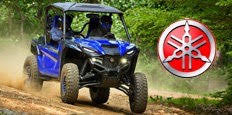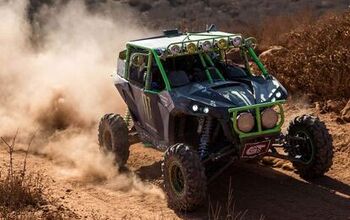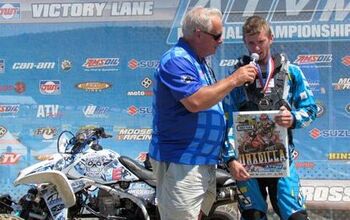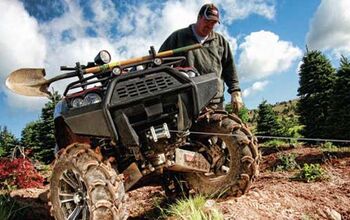ATV Drag Racing 101
Some people get their adrenaline fix on a motocross track, banging bars with a dozen other racers. Others find it dodging trees through the forest on their favorite trail system. For drag racers, adrenaline comes in short, powerful bursts 300 feet at a time.
On our recent outing to the Oregon Dunefest we spent a good bit of time watching ATVs, side-by-sides and just about any other high horsepower contraption you can imagine making tracks down the drag strip. Drag racing is a huge part of the weeklong festivities held every year and people come from across the country to test man and machine for the title of king of the dunes.
While there is no nationally sanctioned drag racing series in the United States for ATVs, you’ll find plenty of local series held in different parts of the country enabling these high-speed junkies to get their fix. Though racers aren’t competing for a national championship, winners do get to claim bragging rights and some of the classes offer a cash purse. Not only does an event like Dunefest bring out some of the fastest quads and side-by-sides, but you’re sure to see lots of bling and plenty of one-off creations.
Additionally, an event like Dunefest offers classes for just about everyone. Organizers break it down by manufacturer with the Honda Hoedown, the Suzuki Shootout and the Banshee Bash. Any machine by that particular manufacturer is eligible. Racers can also compete in the thumper wars for 4-strokes only, broken into two classes: below 500cc and 500cc-unlimited. Additionally, the King of the Dunes event is open to all first- and second-place finishers throughout the week.
Once you’ve figured out which class you’re going to race, it’s time to get down to business. Drag racing is much more complex than simply lining up next to someone and seeing who has the faster machine. In reality it’s more so a test of how well a rider knows and can control his machine. In the old days people may have just lined it up to see who could make it up the hill or down the drag strip fastest, but drag racing today is much more a game of numbers than a test of raw horsepower.
Before we get to the numbers, let’s take a look at the course. When competitors roll to the line the first thing they’ll notice is the lighting tree. The tree has a series of bulbs on top as well as down the sides corresponding to the lane closest to each competitor. On the ground in front of the tree is a set of photocells relaying a series of beams across the drag strip. As competitors enter their lanes their front tires cross the first beam illuminating the first pair of lights – this is called pre-staging. Once they’ve pre-staged, racers ease forward until the second line of bulbs is illuminated, declaring themselves staged. Once both competitors have staged, the tree will be illuminated with a random delay of one to three seconds. The three remaining amber bulbs will light up in intervals of four tenths of a second before the final green bulb signals go.
Prior to actual competition, most events will have at least a day to test and tune. This allows competitors the opportunity to fine tune their machines to the specific environment. They often play with different tire and wheel setups, sprocket sizes, and jetting. Elevation has a huge effect on how well engines will run due to the amount of oxygen in the air. Higher elevations have less oxygen (think running out of breath while hiking a mountain trail), while sea level has a higher oxygen level. More oxygen means engines run hotter.
Since drag racing involves getting the most out of your engine, taking a few practice runs to dial it in is definitely in your best interest. With sand drags, I’ve even heard racers talk about one lane running faster than the other. Moisture in the sand or fresh sand blown in by the wind can create minor differences that might not be apparent to the naked eye but can actually slow you down.
Once you’ve got your machine dialed in it’s time to go bracket racing. Bracket racing is a form of handicap racing created to give competitors with varying engine sizes a fair shot at competing. It would be next to impossible to ensure every ATV lines up against someone with the same or similar modifications. Enter the “dial time.” A dial time is essentially the absolute best time you think that you could possibly make it down the drag strip. After making several practice runs down the strip you select what you feel would be an appropriate dial time. You’re goal then becomes to get as close to that dial time as possible without beating it, or breaking out. The clock begins when the tires roll forward out of staging beam on the photocell and ends when they cross the finish line. If you break out, you lose. However, if your competitor also breaks out, the person who broke out the least will win the race.
This is where drag racing really becomes a numbers game. In addition to racing against their dial time, racers are also judged on their reaction time – the time it took for them to leave the line. The reaction timer begins when the green light illuminates and ends when the competitor’s front tires leave the staging beam. We’re talking fractions of a second – at least for competent racers.
A good reaction time is imperative in bracket racing. The purpose of the dial time is to give the underdog a bit of a head start, but if he reacts slower and the other racer reacts quickly, the handicap didn’t help him. Suppose the racer in lane 1 selects a dial time of seven seconds and lane 2 believes his best time would be eight seconds. Both racers dial times are entered into the computer and the computer will start the tree for lane 2 one second ahead of lane 1. The idea is that the one-second advantage will be made up by the competitor in lane 1 by the time both racers reach the end of the drag strip since he’s running a faster time. For both racers, the elapsed time doesn’t start until their tires leave the stage beam.
Now for the racer in lane 2 to take full advantage of his head start, his reaction time needs to be as small as possible. If he delays and it takes him a full second to react and his competitor in lane 1 reacts in half the time, he’s already lost half of his one-second handicap. Even though he gets off the line a half second ahead of his competitor, he’ll likely lose the race because his competitor is running a faster time down the drag strip. He may even finish closer to his dial time, but when his slow reaction time is added to his elapsed time he’ll be behind in the end because the other racer had a better reaction time.
In simpler terms, reaction time plus the difference between your dial time and your elapsed time equals your final run time.
The winner is still going to be the first person to cross the finish line without breaking out. For that reason, many racers will actually slow down if they find they have a comfortable lead to make sure they don’t beat their dial time.
It can be a bit confusing at first, but experienced drag racers learn a lot of tips to improve and almost eliminate their reaction time. Knowing your machine and how long it takes to get moving after you dump the clutch will give you an idea of how soon you can leave the line. The best racers practice their timing so much that they can actually leave the line as the green light is illuminating – a pretty impressive feat that comes with lots of practice and countless runs down the drag strip.
The bracket racing format was created to keep things fair. Without some form of handicap it would boil down to who has the deepest pockets and can build the fastest engine. Bracket racing give the underdog a fair shot at winning, but still requires a certain level of skill to select an appropriate dial time and then run as close to it as possible without going over.
If you’re a total newbie or you’re afraid your machine isn’t trick enough to try drag racing, don’t be alarmed. I’ve seen everything from custom CBR1000 quads to tri-zinger 60’s (complete with tow behind cooler) running down the drag strip. If you get the chance, try to attend an event like Dunefest where there are plenty of first timers and more than enough friendly folks to answer any questions and help get you to the line.
Related Reading
Growing up in Oregon, most of Seth's involvement in the powersports world was limited to what he saw in magazines and videos. Following a brief stint in the corporate world, Seth took a flying leap (literally) and moved to California to pursue a career in freestyle motocross. Though short lived, the opportunity immersed him in the industry and is now a well-established off-road writer.
More by Seth Fargher



































